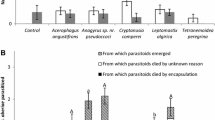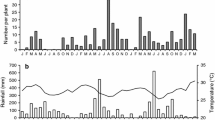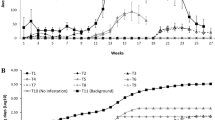Abstract
Following the successful introduction ofEpidinocarsis lopezi (De Santis) for biological control of the cassava mealybug (CM)Phenacoccus manihoti Mat.-Ferr. in southwestern Nigeria in 1981 and 1982, 11 groups of cassava fields were sampled every 2 weeks up to 1988 for impact assessment. After 1984, CM populations remained mostly below 10 per tip despite the presence of native hyperparasitoids, demonstrating the long-term success of biological control byE. lopezi in the region. Indigenous polyphagous coccinellids were found only during peak host densities, whereas the specificE. lopezi was common throughout the year. During some periods, percentage parasitism indicated delayed density dependence. Since 89% of all sampled cassava tips had no CM at all and the parasitisme is very mobile, parasitization rates were also calculated for individual infested tips (N=4,878). Parasitism increased slightly with host density on tips having between 1 and 10 CM of the 3rd and 4th instars, indicating positive density dependence. Such tips comprised 64% of all infested tips. At higher host densities, parasitism rates fell rapidly. The results are discussed in view of different theories on population regulation by biological control agents.
Résumé
Suite à l'introduction d'Epidinocarsis lopezi (De Santis) en vue d'une lutte biologique contre la cochenille du manioc (CM)Phenacoccus manihoti Mat.-Ferr. dans le sud-ouest du Nigéria en 1981 et 1982, 11 groupes de champs situés dans 2 régions ont été échantillonnés toutes les 2 semaines jusqu'en 1988, afin d'estimer l'impact de cet auxiliaire. Les populations du ravageur sont restées au-dessous de 10 CM par pousse la plupart du temps, malgré la présence d'hyperparasitoïdes indigènes, prouvant ainsi le succès continu de la lutte biologique parE. lopezi dans la région. Les coccinelles indigènes et polyphages n'ont été présentes que pendant les sommets de population de la CM, tandis que le parasitoïde spécifique était commun toute l'année. Pendant certaines périodes la courbe du parasitisme suggère une dépendance de la densité retardée. Comme 89% de toutes les pousses sont exemptes de la cochenille et comme le parasitoïde est très mobile, les taux de parasitisme ont été calculés sur la base des pousses individuelles. Malgré la grande variance des données couvrant 4 878 pousses infestées, une légére augmentation du parasitisme et, par conséquent, une dépendance positive de la densité sont constatées sur toutes les pousses ayant entre 1 et 10 CM du 3e et 4e stade. De telles pousses représentent 64% de toutes les pousses infestées. Aux densités d'hôte plus élevées le degré de parasitisme diminue rapidement. Les résultats sont discutés à la lumière des différentes théories sur la régulation des populations par les ennemies naturels.
Similar content being viewed by others
References
Biassangama, A., Fabres, G. &Nénon, J.P. — 1988. Parasitisme au laboratoire et au champ d'Epidinocarsis (Apoanagyrus) lopezi [Hym.: Encyrtidae] auxiliaire exotique introduit au Congo pour la régulation de l'abondance dePhenacoccus manihoti [Hom.: Pseudococcidae]. —Entomophaga, 33, 453–465.
Dempster, J. P. &Pollard, E. — 1986. Spatial heterogeneity, stochasticity and the detection of density dependence in animal populations. —Oikos, 46, 413–416.
Fabres, G. — 1981. Première quantification du phénomène de gradation des populations dePhenacoccus manihoti Matile-Ferrero [Hom.: Pseudococcidae] en République Populaire du Congo. —Agronomie, 1, 483–486.
Fabres, G. — 1982. Bioécologie de la cochenille du manioc [Phenacoccus manihoti, Hom.: Pseudococcidae] en République Populaire du Congo. —Agron. Trop., 36, 369–377.
Fabres, G. &Matile-Ferrero D. — 1980. Les entomophages inféodés à la cochenille du manioc,Phenacoccus manihoti [Hom.: Coccoidea, Pseudococcidae] en République Populaire du Congo. Les composantes de l'entomocœnose et leurs inter-relations. —Ann. Soc. Entomol. Fr. (N.S.), 16, 509–515.
Gutierrez, A. P., Wermelinger, B., Schulthess, F., Baumgärtner, J. U., Herren, H.R., Ellis, C. K. &Yaninek, J. S.— 1988a. Analysis of biological control of cassava pests in Africa. I. Simulation of carbon, nitrogen and water dynamics in cassava. —J. Appl. Ecol., 25, 901–920.
Gutierrez, A. P., Neuenschwander, P., Schulthess, F., Herren, H. R., Baumgärtner, J. U., Wermelinger, B., Löhr, B. &Ellis, C. K. —1988b. Analysis of biological control of cassava pests in Africa. II. Cassava mealybugPhenacoccus manihoti. —J. Appl. Ecol., 25, 921–940.
Hammond, W. N. O., Neuenschwander, P. &Herren, H. R. — 1987. Impact of the exotic parasitoidEpidinocarsis lopezi on cassava mealybug [Phenacoccus manihoti] populations. —Insect Sci. Applic., 8, 887–891.
Hammond, W. N. O., van Alphen, J. J. M., Neuenschwander, P. & van Dijken, M. J. — 1989. Aggregative and mutual interference in field populations ofEpidinocarsis lopezi (De Santis) [Hym.: Encyrtidae], a parasitoid of the cassava mealybug [Phenacoccus manihoti Mat.-Ferr.Hom.: Pseudococcidae]. —Oecologia (in press).
Hassell, M. P. — 1978. The dynamics of arthropod predator prey systems. Monographs in population biology. —Princeton University Press, Princeton.
Hassell, M. P. — 1984. Parasitism in patchy environments: inverse density dependence can be stabilizing. —I.M.A.J. J. math. appl. med. Biol., 1, 123–133.
Hassell, M. P. — 1985. Insect natural enemies as regulating factors. —J. Anim. Ecol., 54, 323–334.
Hennessey, R. D. &Muaka, T. — 1987. Field biology of the cassava mealybug,Phenacoccus manihoti and its natural enemies in Zaire. —Insect Sci. Applic., 8, 899–903.
Herren, H. R. &Lema, K. M. — 1982. CMB-first successful releases. —Biocontrol News and Info. C.A.B., 3, 185.
Herren, H. R., Neuenschwander, P., Hennessey, R. D. &Hammond, W. N. O. — 1987. Introduction and dispersal ofEpidinocarsis lopezi [Hym.: Encyrtidae], an exotic parasitoid of the cassava mealybug,Phenacoccus manihoti [Hom.: Pseudococcidae], in Africa. —Agric. Ecosyst. Environ., 19, 131–144.
Huffaker, C. B. &Messenger, P. — 1964. The concept and significance of natural control. In: Biological control of insect pests and weeds (P. DeBach &E. I. Schlinger, eds.), pp. 74–117. —Chapman & Hall, London.
Iziquel, Y. &LeRü, B. — 1989. Influence de l'hyperparasitisme sur les populations d'un hyménoptère encyrtidae,Epidinocarsis lopezi parasitoïde exotique de la cochenille du maniocPhenacoccus manihoti Mat.-Ferr. introduit au Congo. —Entomol. Exp. Appl., 52, 239–247.
Kraaijeveld, A. R. &van Alphen, J. J. M. — 1986. Host-stage selection and sex allocation byEpidinocarsis lopezi [Hymenoptera: Encyrtidae], a parasitoid of the cassava mealybug,Phenacoccus manihoti [Homoptera: Pseudococcidae]. —Med. Fac. Landbouww. Rijksuniv. Gent., 51, 1067–1078.
Legner, E. F. — 1969. Distribution pattern of hosts and parasitisation bySpalangia drosophilae [Hymenoptera, Pteromalidae]. —Can. Entomol., 101, 551–557.
Lema, K. M. &Herren, H. R. — 1985. Release and establishment in Nigeria ofEpidinocarsis lopezi, a parasitoid of the cassava mealybug,Phenacoccus manihoti. —Entomol. Exp. Appl., 38, 171–175.
Lema, K. M., Herren, H. R. &Neuenschwander, P. — 1984. Impact ofE. lopezi on the CM. —IITA Ann. Rep., 1983, 119–120.
LeRü, B. &Iziquel, Y. — 1988. Evaluation de l'incidence mécanique des pluies, à l'aide d'un simulateur de pluies, sur la dynamique de populations de la cochenille du manioc,Phenacoccus manihoti. — pp. 19–22, In La cochenille du manioc et sa Biocenose au Congo: 1985–1987. ORSTOM, Paris.
LeRü, B., Iziquel, Y., Biassangama, A. &Kiyindou, A. — 1988. Comparaison des effectifs de la cochenille du maniocPhenacoccus manihoti avant et après introduction d'Epidinocarsis lopezi Encyrtidae americain, au Congo en 1982. — pp. 1–18, In: La cochenille du manioc et sa Biocenose au Congo: 1985–1987. ORSTOM, Paris.
Löhr, B., Neuenschwander, P., Varela, A. M. &Santos, B. — 1989. Interactions between the female parasitoidEpidinocarsis lopezi (De Santis) [Hym.: Encyrtidae] and its host the cassava mealybug,Phenacoccus manihoti Matile-Ferrero [Hom.: Pseudococcidae]. —Z. Angew. Entomol., 105, 403–412.
May, R. M. &Hassell, M. P. — 1988. Population dynamics and biological control. —Phil. Trans. R. Soc. Lond. B. 318, 129–169.
Murdoch, W. W., Chesson, J. &Chesson, P. L. — 1985. Biological control in theory and practice. —Am. Nat., 125, 344–366.
Nadel, H. &van Alphen, J. J. M. — 1987. The role of host and host plant odours in the attraction of a parasitoid,Epidinocarsis lopezi, to the habitat of its host, the cassava mealybug,Phenacoccous manihoti. —Entomol. Exp. Appl., 45, 181–186.
Neuenschwander, P. &Hammond, W. N. O. — 1988. Natural enemy activity following the introduction ofEpidinocarsis lopezi [Hymenoptera: Encyrtidae] against the cassava meallybugPhenacoccus manihoti [Homoptera: Pseudococcidae], in southwestern Nigeria. —Environ. Entomol., 17, 894–902.
Neuenschwander, P. &Herren, H. R. — 1988. Biological control of the cassava mealybug,Phenacoccus manihoti, by the exotic parasitoidEpidinocarsis lopezi in Africa. —Phil. Trans. R. Soc. Lond. B. 318, 319–333.
Neuenschwander, P. &Madojemu, E. — 1986. Mortality of the cassava mealybug,Phenacoccus manihoti Mat.-Ferr. [Hom.: Pseudococcidae], associated with an attack byEpidinocarsis lopezi [Hym.: Encyrtidae]. —Mitt. schweiz. entomol. Ges., 59, 57–62.
Neuenschwander, P., Hammond, W. N. O., Gutierrez, A. P., Cudjoe, A. R., Baumgärtner, J. U., Regev, U. &Adjakloe, R. — 1989a. Impact assessment of the biological control of the cassava mealybug,Phenacoccus manihoti Matile-Ferrero [Hemiptera: Pseudococcidae] by the introduced parasitoidEpidinocarsis lopezi (De Santis) [Hymenoptera: Encyrtidae]. —Bull. Entomol. Res., 79, 579–594.
Neuenschwander, P., Haug, T., Ajuonu, O., Davis, H., Akinwumi, B. &Madojemu, E. — 1989b. Quality requirements in natural enemies used for inoculative release: Practical experience from a successful biological control programme. —Z. Angew. Entomol., 108, 409–420.
Neuenschwander, P., Hennessey, R. D. &Herren, H. R. — 1987. Food web of insects associated with the cassava mealybugPhenacoccus manihoti Matile-Ferrero [Hemiptera: Pseudococcidae], and its introduced parasitoidEpidinocarsis lopezi [Hymenoptera: Encyrtidae], in Africa. —Bull. Entomol. Res., 77, 177–189.
Neuenschwander, P., Schulthess, F. &Madojemu, E. — 1986. Experimental evaluation of the efficiency ofEpidinocarsis lopezi, a parasitoid introduced into Africa against the cassava mealybugPhenacoccus manihoti. —Entomol. Exp. Appl., 41, 133–138.
Nsiama She, N. D. — 1987. Progrès enregistré en matière de lutte biologique contre la cochenille farineuse du manioc au Zaire, pp. 245–265. In: Séminaire sur les maladies et les ravageurs des principales cultures vivrières d'Afrique centrale, Bujumbura, 16–20 Feb. 1987.
Odebiyi, J. A. &Bokonon-Ganta, A. H. — 1986. Biology ofEpidinocarsis (=Apoanagyrus) lopezi [Hymenoptera: Encyrtidae] an exotic parasite of cassava mealybug,Phenacoccus manihoti [Homoptera: Pseudococcidae] in Nigeria. —Entomophaga, 31, 251–260.
Schulthess, F. — 1987. The interaction between cassava mealybugPhenacoccus manihoti (Mat.-Ferr.) populations and cassava (Manihot esculenta Crantz) as influenced by weather. —Ph. D.-thesis, Swiss Federal Institute of Technology, Zürich, Switzerland.
Schulthess, F., Baumgärtner, J. U. &Herren, H. R. — 1987. Factors influencing the life table statistics of the cassava mealybugPhenacoccus manihoti. —Insect Sci. Applic., 8, 851–856.
Schulthess, F., Baumgärtner, J. U. &Herren, H. R. — 1989. SamplingPhenacoccus manihoti in cassava fields in Nigeria. —Trop. Pest Managt., 35, 193–200.
Stern, V. M., Smith, R. F. &van den Bosch, R. — 1959. The integration of chemical and biological control of the spotted alfalfa aphid. The integrated control concept. —Hilgardia, 29, 81–101.
Taylor, L. R. — 1961. Aggregation, variance and the mean. —Nature, 189, 732–735.
Van den Meiracker, R. A. F., Hammond, W. N. O. &van Alphen, J. J. M. — 1988. The role of kairomones in prey finding in the coccinellidsDiomus sp. andExochomus sp., predators of the cassava mealybug,Phenacoccus manihoti. —Med. Fac. Landbouww. Rijksuniv. Gent., 53, 1063–1077.
Van Driesche, R. G. — 1983. Meaning of “percent parasitism” in studies of insect parasitoids. —Environ. Entomol., 12, 1611–1622.
Waage, J. K. — 1983. Aggregation in field parasitoid populations: foraging time allocation by a population ofDiadegma [Hymenoptera, Ichneumonidae]. —Ecol. Entomol., 8, 447–453.
Author information
Authors and Affiliations
Rights and permissions
About this article
Cite this article
Hammond, W.N.O., Neuenschwander, P. Sustained biological control of the cassava mealybugPhenacoccus manihoti [Hom.: Pseudococcidae] byEpidinocarsis lopezi [Hym.: Encyrtidae] in Nigeria. Entomophaga 35, 515–526 (1990). https://doi.org/10.1007/BF02375086
Received:
Accepted:
Issue Date:
DOI: https://doi.org/10.1007/BF02375086




